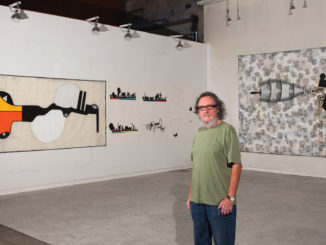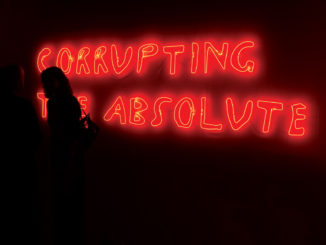 Like many artists who ply their trade in studios, warehouses, and garages around the world, David Zalben says it’s not about the money. It’s about connecting with people. “Every day I’m here is an opportunity to meet somebody new. It’s not just about making a sale.”
Like many artists who ply their trade in studios, warehouses, and garages around the world, David Zalben says it’s not about the money. It’s about connecting with people. “Every day I’m here is an opportunity to meet somebody new. It’s not just about making a sale.”
And if Zalben were a solitary artist, in a lonely studio, in some godforsaken part of town, his social appetite might seem strange. But Zalben’s tidy, little workspace is on Lincoln Road, Miami Beach’s famed pedestrian thoroughfare, where every year thousands of people stroll, and strut, amidst stores, restaurants, and clubs.
Tucked into a two-storey, 1930’s-era, art deco building, Zalben’s studio has no street-level presence. He shares the partitioned, former department store with 27 other emerging artists. 13 more work in a similar building just down the street. They all pay very little in rent, help each other along, and enjoy the kind of exposure only dreamed of by most visual artists.
What makes for such favorable artistic conditions?: ArtCenter / South Florida, a 25-year-old non-profit aimed at doing everything one organization can possibly do to advance the knowledge of contemporary art in Miami.
Founded in 1984, ArtCenter opened its doors at a time when nobody but the elderly, homeless, and recently-paroled lurked on the rundown, boarded-up Lincoln Road strip. Cheap rents lured the center’s founder, Ellie Schneiderman, to the area after she and the rest of Miami’s art community were priced out of Coconut Grove by rising rents and the usual brand of urban gentrification.
Desperate Lincoln Road landlords were happy to have her. The City, wanting to breathe life back into the area, handed her sizable grants. State and federal dollars flowed in, too. And Schneiderman, in time, was able to purchase and renovate four buildings to accommodate a growing band of artists. Other art institutions followed. Some survived longer than others. But Schneiderman’s foresight to purchase buildings, instead of simply leasing them, secured a place for artists on what is now some of the hottest real-estate in the country.
Today, 41 artists-in-residence work in the rent-subsidized studios at ArtCenter. They’re juried in for 3 to 6 months, three years, or a maximum of six years. Unlike in the old days, city code forbids them from sleeping on the premises, but each one commits to spending at least 30 hours a week in their studios and to 10 hours of community service a month, hosting workshops or teaching classes.
“Part of our mission,” says ArtCenter Director Jeremy Chestler, “is to provide the public with access to artists. It’s also about showcasing South Florida talent, even if it’s an artist who has relocated to Miami, they become part of the community. And where better to do it than Lincoln Road. The whole world comes through here.”
“ArtCenter’s street-level gallery at 800 Lincoln Road”, he says, “gets 120,000 walk-ins a year. Many of those visitors wander into the artists’ adjoining studios: And it’s hearing from people who are not necessarily familiar with art history, or who even have the language to express themselves when discussing art, that really helps our artists. We also bring in critics and curators who give them more formalized critique. Outside of art school, that’s not common place and yet so important.”
Brazilian artist Adriana Carvalho, who wields a welding torch and other tools to turn metal into art, agrees that the compliments, critiques, and outright rudeness of some visitors to her studio have made her a better artist: “I learn from the public, from their reactions to my work. You learn not just to open your door, but to open your heart. You have to stop and give your time, because people are more important than art. When I first got here I was so nervous and protective of my work, but I eventually learned how to get out of myself. The compliments, the criticisms, that’s what it’s all about. We need it.”
Luis Garcia-Nerey, an abstract artist represented by galleries around the country, agrees. “It’s a double-edged sword. Some people who come through know about art and some don’t know anything. You have to deal with both and just listen to what they have to say.”
ArtCenter artists exhibit their work at other locations around town, too, like City Hall and in the large display windows of some Walgreen’s pharmacies. A monthly Art Walk, begun last August, recently found a sponsor and has been drawing larger and larger crowds to the studios. And the center’s workshops are seeing higher attendance rates as the economic downturn spurs laid-off workers to seek new skills and creative outlets.
Just as importantly, artists manage to sell their work. “I do well,” says David Zalben. “I try to keep my prices reasonable. It mostly has to do with the amount of time you put yourself here… because selling is an art form. You have to be personable. I think it comes down to likability, not just the energy of your work. In this environment, the artist is just as important as the art.”
Some artists have found commercial success. David Leroi, on his sixth year at ArtCenter, makes a living from his American pop culture-inspired art. The Miami art world, he admits, has not been very receptive to his work, but through the center he has gained exposure and now has collectors in NY, LA, and Europe. “It’s a good place to be,” he says.
ArtCenter takes no cut of their artists’ sales, and only 10 percent from outside artists who are sometimes allowed to exhibit at their gallery. Those small commissions, membership dues, workshop fees, studio rentals, and donations, however, only go so far. And, in recent years, ArtCenter operated at a deficit.
“We’ve had periods of deficit and surplus,” says Director Chestler. “It comes and goes with the economy. We were initially accustomed to receiving a princely sum of money annually in government grants. That, all of a sudden, disappeared and we became very resourceful at developing new streams of revenue. But, overall, the organization is extremely stable.”
Earnings from a $3.8 million endowment, created back in 1998 after the sale of a former ArtCenter property, have helped meet some expenses. And, recently, the organization received government stimulus funds from the National Endowment for the Arts. Chestler affirms, “We started this fiscal year very strong with four new cash sponsors.”
He goes on to point out one specific fundraising hurdle. “The biggest issue here in Miami is that we’re a young community, just over 100 years old, and many people are transitory. So it’s still new for people to understand that they have to support their local art institutions. It’s not just the government or corporations or the wealthy, but you and I, by joining even at the lowest dollar amount and by going to things and paying for things that really makes a difference. It’s all about the educational process at this point and making people aware. That is, if quality of life matters to you.”
And quality of life, he says, is what it’s all about. “Think about a community without any public art. It’s just not as fun of a place to live. Intellectually, it’s not as stimulating. Creatively, it’s not as stimulating. Visual and performing arts let you step away from your everyday life for a moment and live through other people.”
Chestler predicts that in ten years from now ArtCenter will look more or less the same: “We’ll still have artist residency programs with affordable studios, still have public exhibitions free of charge, still have educational programs. I think we’ll continue to grow more sophisticated. I think over time, more capital will be put into our facilities. We’re on the verge of opening a digital media lab… we’ll continue to evolve to meet the needs of our community.”
“But, no matter what size the organization,” he adds, “it’s all about love. You’ve got to have passion and it’s got to be about serving the community. It’s not about serving yourself. It’s about the bigger picture. From what I understand, there’s close to a thousand art non-profits in Miami-Dade County. It brings tears to your eyes when you see some of the things they’re doing and how much they’re helping the community.”
And, of course, for artists like David Zalben, toiling away in his little ArtCenter nook day in and day out, it’ll always be about people, just as much as it is about art: “People are a source of inspiration for me. You know, it really takes two people to create art – one person to make it and one person to appreciate it. It’s a relationship. If not for other people, I wouldn’t even have this opportunity.”



Be the first to comment